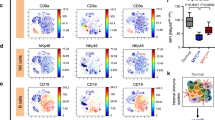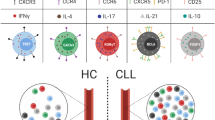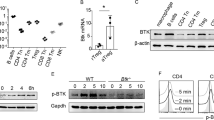Abstract
Loss of function of the tumor suppressor gene PRDM1 (also known as BLIMP1) or deregulated expression of the oncogene BCL6 occurs in a large proportion of diffuse large B cell lymphoma (DLBCL) cases. However, targeted mutation of either gene in mice leads to only slow and infrequent development of malignant lymphoma, and despite frequent mutation of BCL6 in activated B cells of healthy individuals, lymphoma development is rare. Here we show that T cells prevent the development of overt lymphoma in mice caused by Blimp1 deficiency or overexpression of Bcl6 in the B cell lineage. Impairment of T cell control results in rapid development of DLBCL-like disease, which can be eradicated by polyclonal CD8+ T cells in a T cell receptor–, CD28- and Fas ligand–dependent manner. Thus, malignant transformation of mature B cells requires mutations that impair intrinsic differentiation processes and permit escape from T cell–mediated tumor surveillance.
This is a preview of subscription content, access via your institution
Access options
Subscribe to this journal
Receive 12 print issues and online access
$209.00 per year
only $17.42 per issue
Buy this article
- Purchase on Springer Link
- Instant access to full article PDF
Prices may be subject to local taxes which are calculated during checkout






Similar content being viewed by others
Change history
30 May 2014
In the version of this article initially published, the percentages in the top row of Figure 1c were incorrect. The errors have been corrected in the HTML and PDF versions of the article.
References
Schneider, C., Pasqualucci, L. & Dalla-Favera, R. Molecular pathogenesis of diffuse large B-cell lymphoma. Semin. Diagn. Pathol. 28, 167–177 (2011).
Nogai, H., Dorken, B. & Lenz, G. Pathogenesis of non-Hodgkin's lymphoma. J. Clin. Oncol. 29, 1803–1811 (2011).
Rosenwald, A. et al. Molecular diagnosis of primary mediastinal B cell lymphoma identifies a clinically favorable subgroup of diffuse large B cell lymphoma related to Hodgkin lymphoma. J. Exp. Med. 198, 851–862 (2003).
Frick, M., Dorken, B. & Lenz, G. New insights into the biology of molecular subtypes of diffuse large B-cell lymphoma and Burkitt lymphoma. Best Pract. Res. Clin. Haematol. 25, 3–12 (2012).
Alizadeh, A.A. et al. Distinct types of diffuse large B-cell lymphoma identified by gene expression profiling. Nature 403, 503–511 (2000).
Lenz, G. & Staudt, L.M. Aggressive lymphomas. N. Engl. J. Med. 362, 1417–1429 (2010).
Rui, L., Schmitz, R., Ceribelli, M. & Staudt, L.M. Malignant pirates of the immune system. Nat. Immunol. 12, 933–940 (2011).
Shapiro-Shelef, M. et al. Blimp-1 is required for the formation of immunoglobulin secreting plasma cells and pre-plasma memory B cells. Immunity 19, 607–620 (2003).
Kallies, A. et al. Initiation of plasma-cell differentiation is independent of the transcription factor Blimp-1. Immunity 26, 555–566 (2007).
Mandelbaum, J. et al. BLIMP1 is a tumor suppressor gene frequently disrupted in activated B cell–like diffuse large B cell lymphoma. Cancer Cell 18, 568–579 (2010).
Calado, D.P. et al. Constitutive canonical NF-κB activation cooperates with disruption of BLIMP1 in the pathogenesis of activated B cell–like diffuse large cell lymphoma. Cancer Cell 18, 580–589 (2010).
Ye, B.H. et al. Alterations of a zinc finger-encoding gene, BCL-6, in diffuse large-cell lymphoma. Science 262, 747–750 (1993).
Iqbal, J. et al. Distinctive patterns of BCL6 molecular alterations and their functional consequences in different subgroups of diffuse large B-cell lymphoma. Leukemia 21, 2332–2343 (2007).
Dent, A.L., Shaffer, A.L., Yu, X., Allman, D. & Staudt, L.M. Control of inflammation, cytokine expression, and germinal center formation by BCL-6. Science 276, 589–592 (1997).
Muramatsu, M. et al. Class switch recombination and hypermutation require activation-induced cytidine deaminase (AID), a potential RNA editing enzyme. Cell 102, 553–563 (2000).
Pasqualucci, L. et al. BCL-6 mutations in normal germinal center B cells: evidence of somatic hypermutation acting outside Ig loci. Proc. Natl. Acad. Sci. USA 95, 11816–11821 (1998).
Shen, H.M., Peters, A., Baron, B., Zhu, X. & Storb, U. Mutation of BCL-6 gene in normal B cells by the process of somatic hypermutation of Ig genes. Science 280, 1750–1752 (1998).
Yamane, A. et al. Deep-sequencing identification of the genomic targets of the cytidine deaminase AID and its cofactor RPA in B lymphocytes. Nat. Immunol. 12, 62–69 (2011).
Cattoretti, G. et al. Deregulated BCL6 expression recapitulates the pathogenesis of human diffuse large B cell lymphomas in mice. Cancer Cell 7, 445–455 (2005).
Grulich, A.E., van Leeuwen, M.T., Falster, M.O. & Vajdic, C.M. Incidence of cancers in people with HIV/AIDS compared with immunosuppressed transplant recipients: a meta-analysis. Lancet 370, 59–67 (2007).
Schreiber, R.D., Old, L.J. & Smyth, M.J. Cancer immunoediting: integrating immunity's roles in cancer suppression and promotion. Science 331, 1565–1570 (2011).
Challa-Malladi, M. et al. Combined genetic inactivation of β2-Microglobulin and CD58 reveals frequent escape from immune recognition in diffuse large B cell lymphoma. Cancer Cell 20, 728–740 (2011).
Rimsza, L.M. et al. Loss of MHC class II gene and protein expression in diffuse large B-cell lymphoma is related to decreased tumor immunosurveillance and poor patient survival regardless of other prognostic factors: a follow-up study from the Leukemia and Lymphoma Molecular Profiling Project. Blood 103, 4251–4258 (2004).
Smyth, M.J. et al. Perforin-mediated cytotoxicity is critical for surveillance of spontaneous lymphoma. J. Exp. Med. 192, 755–760 (2000).
Street, S.E. et al. Innate immune surveillance of spontaneous B cell lymphomas by natural killer cells and γδ T cells. J. Exp. Med. 199, 879–884 (2004).
Kallies, A. et al. Plasma cell ontogeny defined by quantitative changes in blimp-1 expression. J. Exp. Med. 200, 967–977 (2004).
Kutok, J.L. & Wang, F. Spectrum of Epstein-Barr virus–associated diseases. Annu. Rev. Pathol. 1, 375–404 (2006).
Lee, K.S., Groshong, S.D., Cool, C.D., Kleinschmidt-DeMasters, B.K. & van Dyk, L.F. Murine gammaherpesvirus 68 infection of IFNγ unresponsive mice: a small animal model for gammaherpesvirus-associated B-cell lymphoproliferative disease. Cancer Res. 69, 5481–5489 (2009).
D'Costa, K. et al. Blimp1 is limiting for transformation in a mouse plasmacytoma model. Blood 113, 5911–5919 (2009).
Pasqualucci, L. et al. AID is required for germinal center-derived lymphomagenesis. Nat. Genet. 40, 108–112 (2008).
Stopeck, A.T. et al. Loss of B7.2 (CD86) and intracellular adhesion molecule 1 (CD54) expression is associated with decreased tumor-infiltrating T lymphocytes in diffuse B-cell large-cell lymphoma. Clin. Cancer Res. 6, 3904–3909 (2000).
Salek-Ardakani, S. et al. B cell–specific expression of B7–2 is required for follicular TH cell function in response to vaccinia virus. J. Immunol. 186, 5294–5303 (2011).
Victora, G.D. et al. Germinal center dynamics revealed by multiphoton microscopy with a photoactivatable fluorescent reporter. Cell 143, 592–605 (2010).
Man, K. et al. The transcription factor IRF4 is essential for TCR affinity-mediated metabolic programming and clonal expansion of T cells. Nat. Immunol. 14, 1155–1165 (2013).
Kaech, S.M. & Cui, W. Transcriptional control of effector and memory CD8+ T cell differentiation. Nat. Rev. Immunol. 12, 749–761 (2012).
Burnet, F.M. The concept of immunological surveillance. Prog. Exp. Tumor Res. 13, 1–27 (1970).
Willimsky, G. & Blankenstein, T. The adaptive immune response to sporadic cancer. Immunol. Rev. 220, 102–112 (2007).
Zhang, B. et al. Immune surveillance and therapy of lymphomas driven by Epstein-Barr virus protein LMP1 in a mouse model. Cell 148, 739–751 (2012).
Pasqualucci, L. et al. Expression of the AID protein in normal and neoplastic B cells. Blood 104, 3318–3325 (2004).
Kitano, M. et al. Bcl6 protein expression shapes pre–germinal center B cell dynamics and follicular helper T cell heterogeneity. Immunity 34, 961–972 (2011).
Kolar, G.R., Mehta, D., Pelayo, R. & Capra, J.D. A novel human B cell subpopulation representing the initial germinal center population to express AID. Blood 109, 2545–2552 (2007).
Marshall, J.L. et al. Early B blasts acquire a capacity for Ig class switch recombination that is lost as they become plasmablasts. Eur. J. Immunol. 41, 3506–3512 (2011).
Kaji, T. et al. Distinct cellular pathways select germline-encoded and somatically mutated antibodies into immunological memory. J. Exp. Med. 209, 2079–2097 (2012).
Rosenberg, S.A., Restifo, N.P., Yang, J.C., Morgan, R.A. & Dudley, M.E. Adoptive cell transfer: a clinical path to effective cancer immunotherapy. Nat. Rev. Cancer 8, 299–308 (2008).
Bolitho, P. et al. Perforin-mediated suppression of B-cell lymphoma. Proc. Natl. Acad. Sci. USA 106, 2723–2728 (2009).
Koebel, C.M. et al. Adaptive immunity maintains occult cancer in an equilibrium state. Nature 450, 903–907 (2007).
Davidson, W.F., Giese, T. & Fredrickson, T.N. Spontaneous development of plasmacytoid tumors in mice with defective Fas–Fas ligand interactions. J. Exp. Med. 187, 1825–1838 (1998).
Stel, A.J. et al. Fas receptor clustering and involvement of the death receptor pathway in rituximab-mediated apoptosis with concomitant sensitization of lymphoma B cells to fas-induced apoptosis. J. Immunol. 178, 2287–2295 (2007).
Pasqualucci, L. et al. Analysis of the coding genome of diffuse large B-cell lymphoma. Nat. Genet. 43, 830–837 (2011).
Lohr, J.G. et al. Discovery and prioritization of somatic mutations in diffuse large B-cell lymphoma (DLBCL) by whole-exome sequencing. Proc. Natl. Acad. Sci. USA 109, 3879–3884 (2012).
Straus, S.E. et al. The development of lymphomas in families with autoimmune lymphoproliferative syndrome with germline Fas mutations and defective lymphocyte apoptosis. Blood 98, 194–200 (2001).
Müschen, M., Rajewsky, K., Kronke, M. & Kuppers, R. The origin of CD95-gene mutations in B-cell lymphoma. Trends Immunol. 23, 75–80 (2002).
Kojima, Y. et al. Fas and Fas ligand expression on germinal center type-diffuse large B-cell lymphoma is associated with the clinical outcome. Eur. J. Haematol. 76, 465–472 (2006).
Wang, S.S. et al. Common gene variants in the tumor necrosis factor (TNF) and TNF receptor superfamilies and NF-κB transcription factors and non-Hodgkin lymphoma risk. PLoS ONE 4, e5360 (2009).
Harris, J. et al. Cellular (FLICE) like inhibitory protein (cFLIP) expression in diffuse large B-cell lymphoma identifies a poor prognostic subset, but fails to predict the molecular subtype. Hematol. Oncol. 30, 8–12 (2012).
Novac, N., Baus, D., Dostert, A. & Heinzel, T. Competition between glucocorticoid receptor and NFκB for control of the human FasL promoter. FASEB J. 20, 1074–1081 (2006).
Esser, M.T., Krishnamurthy, B. & Braciale, V.L. Distinct T cell receptor signaling requirements for perforin- or FasL-mediated cytotoxicity. J. Exp. Med. 183, 1697–1706 (1996).
Kessler, B. et al. Peptide modification or blocking of CD8, resulting in weak TCR signaling, can activate CTL for Fas- but not perforin-dependent cytotoxicity or cytokine production. J. Immunol. 161, 6939–6946 (1998).
He, J.S., Gong, D.E. & Ostergaard, H.L. Stored Fas ligand, a mediator of rapid CTL-mediated killing, has a lower threshold for response than degranulation or newly synthesized Fas ligand. J. Immunol. 184, 555–563 (2010).
Shanker, A. et al. Antigen presented by tumors in vivo determines the nature of CD8+ T-cell cytotoxicity. Cancer Res. 69, 6615–6623 (2009).
Kallies, A., Xin, A., Belz, G.T. & Nutt, S.L. Blimp-1 transcription factor is required for the differentiation of effector CD8+ T cells and memory responses. Immunity 31, 283–295 (2009).
Rosenbaum, H. et al. An E μ-v-abl transgene elicits plasmacytomas in concert with an activated myc gene. EMBO J. 9, 897–905 (1990).
Hobeika, E. et al. Testing gene function early in the B cell lineage in mb1-cre mice. Proc. Natl. Acad. Sci. USA 103, 13789–13794 (2006).
Malissen, M. et al. Altered T cell development in mice with a targeted mutation of the CD3-epsilon gene. EMBO J. 14, 4641–4653 (1995).
Shahinian, A. et al. Differential T cell costimulatory requirements in CD28-deficient mice. Science 261, 609–612 (1993).
Pao, L.I. et al. Functional analysis of granzyme M and its role in immunity to infection. J. Immunol. 175, 3235–3243 (2005).
Kägi, D. et al. Cytotoxicity mediated by T cells and natural killer cells is greatly impaired in perforin-deficient mice. Nature 369, 31–37 (1994).
Cretney, E. et al. Increased susceptibility to tumor initiation and metastasis in TNF-related apoptosis-inducing ligand–deficient mice. J. Immunol. 168, 1356–1361 (2002).
Dalton, D.K. et al. Multiple defects of immune cell function in mice with disrupted interferon-γ genes. Science 259, 1739–1742 (1993).
O' Reilly, L.A. et al. Membrane-bound Fas ligand only is essential for Fas-induced apoptosis. Nature 461, 659–663 (2009).
Szabo, S.J. et al. Distinct effects of T-bet in TH1 lineage commitment and IFN-γ production in CD4 and CD8 T cells. Science 295, 338–342 (2002).
Mittrücker, H.W. et al. Requirement for the transcription factor LSIRF/IRF4 for mature B and T lymphocyte function. Science 275, 540–543 (1997).
Hogquist, K.A. et al. T cell receptor antagonist peptides induce positive selection. Cell 76, 17–27 (1994).
Pridans, C. et al. Identification of Pax5 target genes in early B cell differentiation. J. Immunol. 180, 1719–1728 (2008).
Kupresanin, F. et al. Dendritic cells present lytic antigens and maintain function throughout persistent gamma-herpesvirus infection. J. Immunol. 179, 7506–7513 (2007).
Schlissel, M.S., Corcoran, L.M. & Baltimore, D. Virus-transformed pre-B cells show ordered activation but not inactivation of immunoglobulin gene rearrangement and transcription. J. Exp. Med. 173, 711–720 (1991).
Holler, N. et al. Two adjacent trimeric Fas ligands are required for Fas signaling and formation of a death-inducing signaling complex. Mol. Cell. Biol. 23, 1428–1440 (2003).
Acknowledgements
We thank L. Pasqualucci (Columbia University) for Bcl6-transgenic mice, D. Yu (Monash University) for Cd28−/− mice, M. Reth (Albert-Ludwigs-Universität) for Cd79a-Cre mice, L. Wu (Walter and Eliza Hall Institute of Medical Research (WEHI)) for MHC-I antibodies and A. Brooks (University of Melbourne) for antibodies, D. Gray (WEHI) for TCR antibodies, J. Markham for help with the statistical analysis, and P. Schneider (University of Lausanne) for the Fc-FasL. This work was supported by grants and fellowships from the National Health and Medical Research Council of Australia (G.T.B., L.M.C., S.L.N., D.M.T., A.K., A.S., M.J.S. and L.A.O.), the Australia Research Council (A.K., S.L.N.), the Sylvia and Charles Viertel Foundation and the Howard Hughes Medical Institute (A.K., G.T.B.), the Cancer Council Victoria (D.Z.), Cancer Australia and the Cancer Council New South Wales (L.A.O.), and the Leukemia & Lymphoma Society (A.K., L.A.O. and A.S.). This work was made possible through Victorian State Government Operational Infrastructure Support and Australian Government National Health and Medical Research Council Independent Research Institute Infrastructure Support scheme.
Author information
Authors and Affiliations
Contributions
S.A.-S., D.Z. and N.J.B. performed and analyzed the majority of the experiments; A.K.S., L.R., A.E.A. and J.W. conducted and analyzed experiments; F.M. and G.T.B. did infection experiments; L.M.C., L.A.O., A.S., M.J.S., R.J. contributed to the design of experiments; D.M.T. and S.L.N. contributed to the design of the study and the writing of the manuscript; A.K. designed the study, analyzed data and wrote the manuscript.
Corresponding author
Ethics declarations
Competing interests
The authors declare no competing financial interests.
Supplementary information
Supplementary Text and Figures
Supplementary Figures 1–6 (PDF 3551 kb)
Rights and permissions
About this article
Cite this article
Afshar-Sterle, S., Zotos, D., Bernard, N. et al. Fas ligand–mediated immune surveillance by T cells is essential for the control of spontaneous B cell lymphomas. Nat Med 20, 283–290 (2014). https://doi.org/10.1038/nm.3442
Received:
Accepted:
Published:
Issue Date:
DOI: https://doi.org/10.1038/nm.3442
This article is cited by
-
circ_SPEF2 Regulates the Balance of Treg Cells by Regulating miR-16-5p/BACH2 in Lymphoma and Participates in the Immune Response
Tissue Engineering and Regenerative Medicine (2023)
-
Resistance to obinutuzumab-induced antibody-dependent cellular cytotoxicity caused by abnormal Fas signaling is overcome by combination therapies
Molecular Biology Reports (2022)
-
IQGAP2 acts as an independent prognostic factor and is related to immunosuppression in DLBCL
BMC Cancer (2021)
-
Identification of super enhancer-associated key genes for prognosis of germinal center B-cell type diffuse large B-cell lymphoma by integrated analysis
BMC Medical Genomics (2021)
-
Boosting CAR T-cell responses in lymphoma by simultaneous targeting of CD40/4-1BB using oncolytic viral gene therapy
Cancer Immunology, Immunotherapy (2021)



